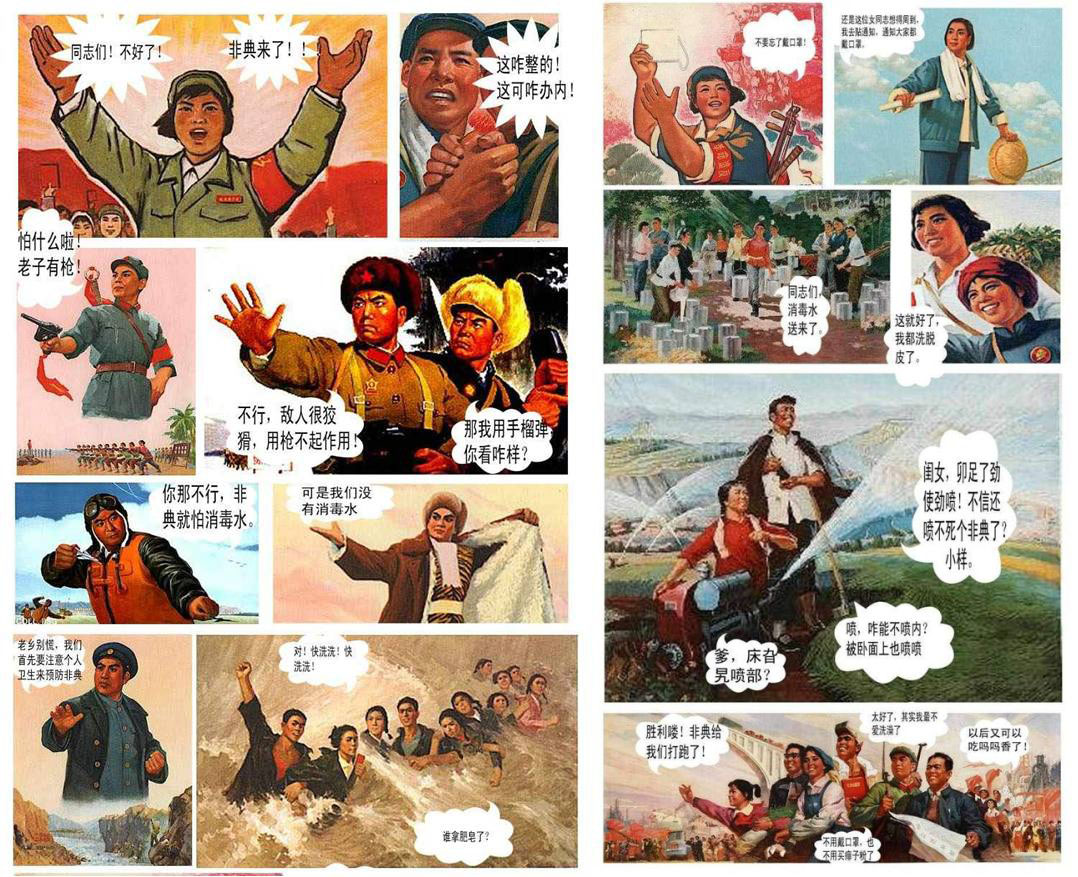Illustration:
ill. 0.1
Date:
2003
Genre:
comic, comic strip
Material:
internet file, colour, original source: photo collage
Source:
DACHS 2009 SARS Yangbanxi, Heidelberg catalogue entry
Inscription:
同志们!不好了!非典来了!!!这整的!这可办内!怕什么啦!老子有枪!不行,敌人很狡猾,用枪不起作用!你那不行,非典就怕消毒水。可是我们没有消毒水 老乡别慌, 我们首先要注意个人卫生来预防非典 对!快洗洗!快洗洗!谁拿肥皂 ?
Keywords:
Yangbanxi, SARS, model heroes, recontextualization, Cultural Revolution, model works, Yang Zirong, Li Yongqi, Hong Changqing, Fang Haizhen, Taking Tiger Mountain by Strategy, Red Detachment of Women, On the Docks, Human Dam, Yan’an Talks, contemporary China
Fighting SARS (Douzheng Sasi 斗争萨斯)

Propagemes from the Cultural Revolution have continued to be in use since the Cultural Revolution ended (and before). There are jokes on citations from the Little Red Book and the model works,there are talk and quizz shows in which memorized quotes from Mao’s works and the model works play a crucial role, there is advertising and art which reproduces and remodels Cultural Revolution propaganda and there are new versions of the images and texts published during the Cultural Revolution in which model heroes are recontextualized to serve, as here, for example, the fight against SARS.
Such repercussions of Cultural Revolution propagemes indicate that the reception of Cultural Revolution propaganda does not accord with a “reflex model.” This propaganda is being enjoyed and hated enormously, it is being debated and destroyed, but also played with and parodied. It is itself manipulated in people’s reactions to it and their (re)enactions of it. In his Yan’an Talks (Mao 1942), Mao raves against a crude poster and slogan style (Mao 1942), but art’s artistic value is dependent on how well it “serves the masses” 为人民服务 wei renmin fuwu. By nature of this ideology (and in complete negation of any Benjaminian or even commonsense theory), the more popular the art work, the higher its artistic achievement—no matter what its artistic achievement. State engagement in entertainment culture during the Cultural Revolution is the attempt to establish a monopoly on popular culture. State propaganda culture is therefore determined less ideologically than structurally.
As in Huxley’s Brave New World in the art of the Cultural Revolution “there are no masterpieces, for masterpieces appeal only to a limited audience” (Huxley 1965:43): the propagandist, however, has to reach as many people as possible. And indeed, each of the main heroes in the model works, such as Yang Zirong in Taking Tiger Mountain by Strategy or Fang Haizhen in On the Dock or Hong Changqing in Red Detachment of Women, is no Hamlet, but more of a Superman. Compared with popular and mass culture rather than high art, i.e. elite art and culture, Cultural Revolutionary propaganda art begins to make sense.








